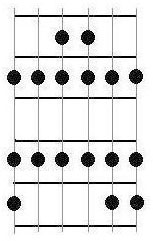Dorian Mode
Dorian Mode

The Dorian mode is named after the Dorian Greeks. Applied to a whole octave, the Dorian octave species was built upon two tetrachords separated by a whole tone. In the diatonic genus, this is the same as playing all the white notes of a piano (ascending, as in the modern reckoning) from E to E: E F G A | B C D E, a note sequence equivalent to medieval/modern Phrygian mode (see below). Placing these two tetrachords together, and the single tone at the bottom of the scale produces the Hypodorian ("below Dorian") mode: A | B C D E | (E) F G A. Placing the two tetrachords together and the single tone at the top of the scale produces the Hyperdorian ("above Dorian") mode, a note sequence equivalent to modern Locrian mode.
Medieval and modern Dorian mode
Dorian mode on CThe early Byzantine church developed a system of eight musical modes (the octoechoi), which served as a model for medieval European chant theorists when they developed their own modal classification system starting in the ninth century. The success of the Western synthesis of this system with elements from the fourth book of De institutione musica of Boethius, created the false impression that the Byzantine oktōēchos were inherited directly from ancient Greece.riginally used to designate one of the traditional harmoniai of Greek theory (a term with various meanings, including the sense of an octave consisting of eight tones), the name was appropriated (along with six others) by the second-century theorist Ptolemy to designate his seven tonoi, or transposition keys. Four centuries later, Boethius interpreted Ptolemy in Latin, still with the meaning of transposition keys, not scales. When chant theory was first being formulated in the ninth century, these seven names plus an eighth, Hypermixolydian (later changed to Hypomixolydian), were again re-appropriated in the anonymous treatise Alia Musica. A commentary on that treatise, called the Nova expositio, first gave it a new sense as one of a set of eight diatonic species of the octave, or scales. Thus, in medieval and modern music, the Dorian mode is a diatonic scale or musical mode which corresponds to the white keys of the piano from "D" to "D". It may be considered an "excerpt" of a major scale played from the pitch a whole tone above the major scale's tonic (in the key of C Major it would be D, E, F, G, A, B, C, D), i.e., a major scale played from its second scale degree up to its second degree again. The resulting scale is, however, minor (or has a minor "feel" or character) because as the "D" becomes the new tonal centre the minor third between the D and the F make us "hear minor". If we build a chord on the tonic, third and fifth, it is a minor chord.
The formula for this can be shown as:
Whole Step - Half Step - Whole Step - Whole Step - Whole Step - Half Step - Whole Step
or more simply:
w-h-w-w-w-h-w
Examples of the Dorian mode include:
The D Dorian mode contains all notes the same as the C major scale starting on D.
The G Dorian mode contains all notes the same as the F major scale starting on G.
The A Dorian mode contains all notes the same as the G major scale starting on A.
The Dorian mode is symmetric, meaning that the pattern of tones and semitones (T-s-T-T-T-s-T) is the same ascending or descending. The difference between the Dorian mode and the modern natural minor (Aeolian) scale is well exemplified in the relative "hardness" of the 6th note of the tune.
The Dorian mode is equivalent to the natural minor scale (or the Aeolian mode) but with the sixth degree raised a semi-tone. Confusingly, the medieval and modern Dorian mode is the same as the Greek Phrygian mode.
